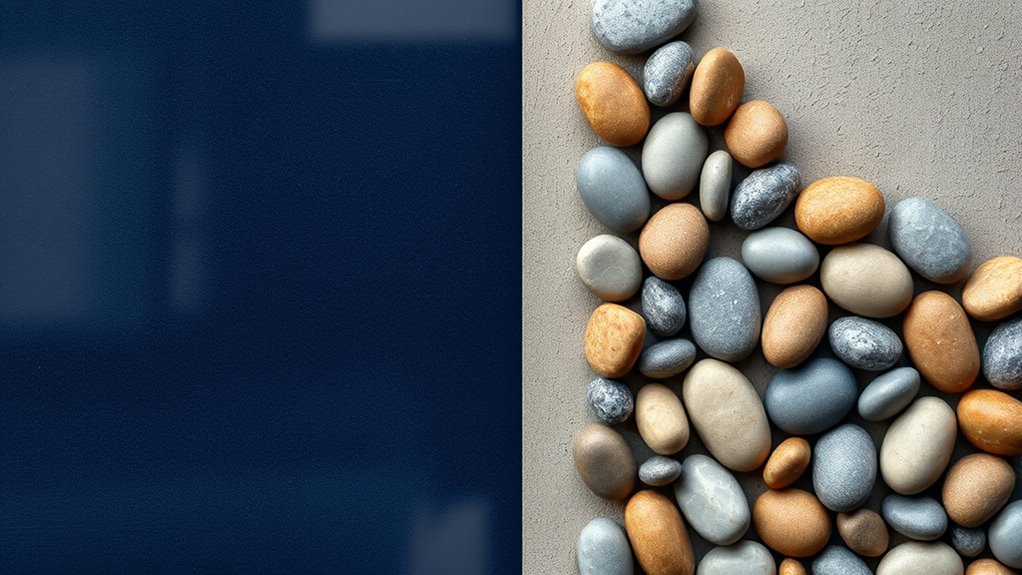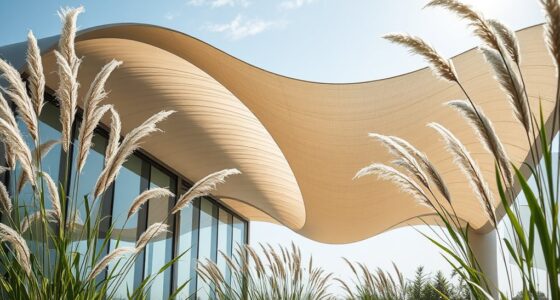When choosing between tile, pebble, or plaster, consider durability, style, and space needs. Tile is ideal for high-traffic or moist areas and offers easy maintenance with sleek patterns. Pebbles give a natural, textured look perfect for organic styles but need regular cleaning. Plaster provides a smooth, versatile surface suited for many interiors but may crack over time. To find the best fit and guarantee long-lasting results, explore each option’s pros and cons further.
Key Takeaways
- Tile is highly durable, easy to clean, and ideal for moisture-prone areas like bathrooms and kitchens.
- Pebble finishes offer a natural, textured look but require regular cleaning and sealing for longevity.
- Plaster provides a smooth, customizable surface suitable for aesthetic versatility but may crack over time if not maintained.
- Installation complexity and costs vary, with tile being labor-intensive, pebble needing special adhesives, and plaster generally quicker to apply.
- Choose finishes based on space function, desired style, maintenance needs, and environmental considerations for long-term performance.
Durability and Maintenance Considerations

When choosing interior finishes, durability and maintenance are key factors to contemplate because they directly impact the longevity and appearance of your space. You want materials that can withstand daily wear, spills, and cleaning without deteriorating quickly. For high-traffic areas, opt for finishes like tile or sealed plaster, which resist scratches and stains more effectively. Consider how easy it is to clean and repair the surface—some finishes require specialized products or skills, which could increase upkeep time and costs. Maintenance routines vary: tile may need grout sealing, while plaster might require periodic touch-ups. Think about your lifestyle and how much effort you’re willing to invest in upkeep. Selecting finishes that balance durability with manageable maintenance ensures your space remains attractive and functional over time. Additionally, understanding how coatings and surface treatments influence surface resilience can help you make more informed decisions.
Aesthetic Appeal and Style Options

Choosing finishes that reflect your personal style can transform a space from ordinary to extraordinary. With tile, pebble, or plaster, you have a variety of aesthetic options to match your vision. Tiles offer clean lines and modern or classic patterns, perfect for sleek, sophisticated looks. Pebbles bring a natural, textured feel, ideal for creating a relaxed, organic atmosphere. Plaster provides a smooth, matte surface that lends itself to artistic, minimalist, or traditional styles. You can choose colors, shapes, and finishes that complement your overall decor. Whether you prefer bold statement pieces or subtle accents, these finishes allow you to express your personality. Additionally, selecting the right interior finish can enhance the durability and overall ambiance of your space. Ultimately, selecting the right finish enhances your space’s character and makes it uniquely yours.
Cost and Installation Factors
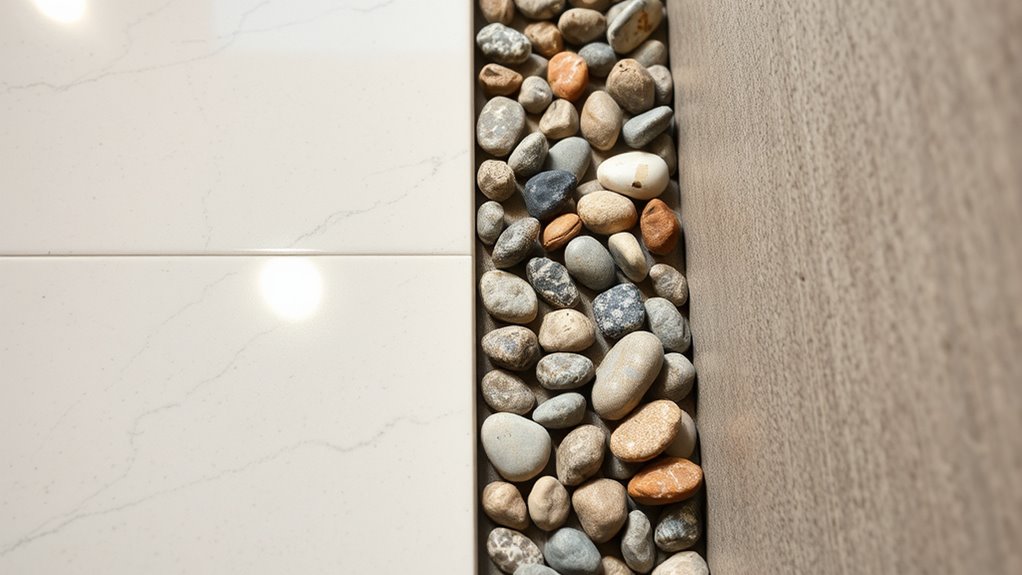
Cost and installation factors considerably influence your choice of interior finishes, as they determine what fits within your budget and timeline. Tile installation can be more expensive and labor-intensive, especially for intricate designs. Pebble finishes may require special adhesives and extra prep work, adding to costs. Plaster tends to be quicker to install but may need skilled labor for a smooth finish, affecting expenses. Consider these factors when planning your project: Material durability is also an important aspect to evaluate for long-term maintenance.
Suitable Spaces and Functionality
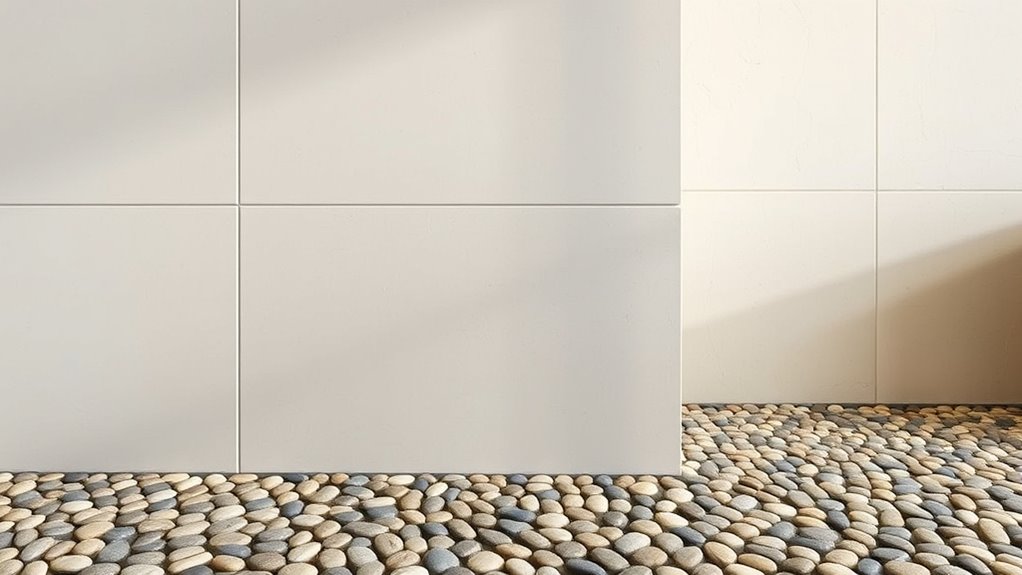
Selecting the right interior finish depends not only on budget and installation considerations but also on the specific spaces and their intended functions. You need finishes that enhance usability and meet safety needs. For high-moisture areas like bathrooms and kitchens, choose water-resistant options such as tile or pebble. In living rooms or bedrooms, plaster provides a smooth, aesthetic surface that’s comfortable for touch. Consider durability for high-traffic zones to prevent damage, and select finishes that align with your style preferences. Additionally, think about maintenance requirements to keep surfaces looking fresh. Properly matching finishes to space functions guarantees longevity, safety, and visual harmony across your home. Moreover, understanding environmentally friendly options can help reduce your home’s carbon footprint and improve energy efficiency. Prioritizing these factors helps you create functional, attractive interiors that serve your daily needs effectively.
Texture and Feel Underfoot or Touch
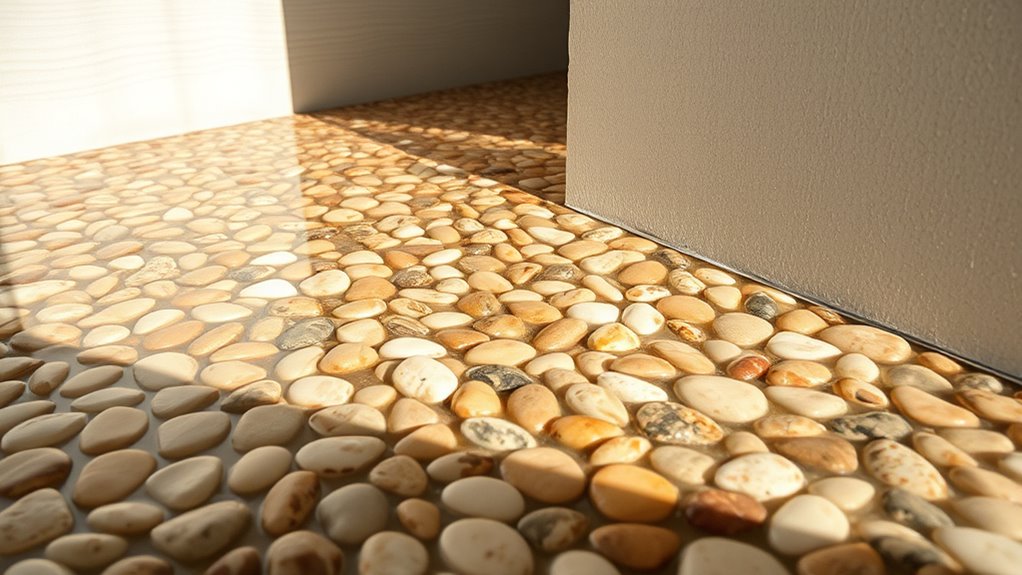
The texture and feel of your flooring and surfaces considerably influence your daily comfort and experience. Different surface textures provide varied tactile sensations, from smooth and sleek to rough and textured. Considering how these variations feel underfoot or touch helps you choose finishes that enhance both comfort and style. For example, selecting surface textures that are gentle on sensitive skin can improve overall comfort, especially for children and the elderly.
Surface Texture Variations
Surface texture plays a crucial role in how your floors feel underfoot or to the touch, influencing both comfort and aesthetic appeal. Different textures create unique experiences, from smooth and sleek to rough and tactile. A polished tile offers a glossy, cool surface, perfect for modern spaces. Pebble finishes provide a natural, textured feel that adds organic charm. Plaster surfaces can be smooth or subtly textured, giving versatility in design. You might prefer a matte, gritty surface for a rustic look or a high-gloss finish for sophistication. Texture impacts not just appearance but also how dirt or moisture interacts with your floor. Choosing the right surface texture ensures your space feels inviting and aligns with your style. Additionally, considering surface durability can help ensure your flooring maintains its appeal over time.
Comfort Underfoot Feel
When choosing interior finishes, how your floors feel underfoot can considerably impact your comfort and overall experience. Soft, plush surfaces like carpets or thick rugs provide warmth and cushioning, making your space inviting and cozy. Hard surfaces such as tile or polished stone are smooth and cool, offering a sleek feel but may be less forgiving unless paired with mats or rugs. Pebble finishes offer a natural, textured sensation that can be both soothing and invigorating, depending on your preference. Keep in mind that a comfortable underfoot experience enhances daily living, whether you’re walking barefoot or wearing shoes. Consider the balance between firmness and softness, as well as how the material’s temperature and texture feel when you stand on it for extended periods. Additionally, the touch and feel of your flooring can influence your mood and sense of well-being in a space.
Tactile Sensation Differences
Choosing the right interior finish involves more than just appearance; how textures feel under your touch or feet influences your overall comfort. Different materials offer distinct tactile sensations that can impact your mood and daily experience. For example, smooth tiles feel cool and sleek, perfect for modern spaces. Pebble surfaces provide a natural, textured underfoot experience, adding a sense of grounding. Plaster finishes have a soft, matte touch that’s warm to the skin. Consider how each texture interacts with your movement and touch, shaping your environment’s ambiance.
- Smooth, polished tiles feel cool and refined
- Textured pebble surfaces add natural roughness
- Soft plaster offers a warm, matte touch
- Bumpy or embossed finishes create tactile interest
- Hard, glossy surfaces reflect light and feel slick
Environmental Impact and Sustainability
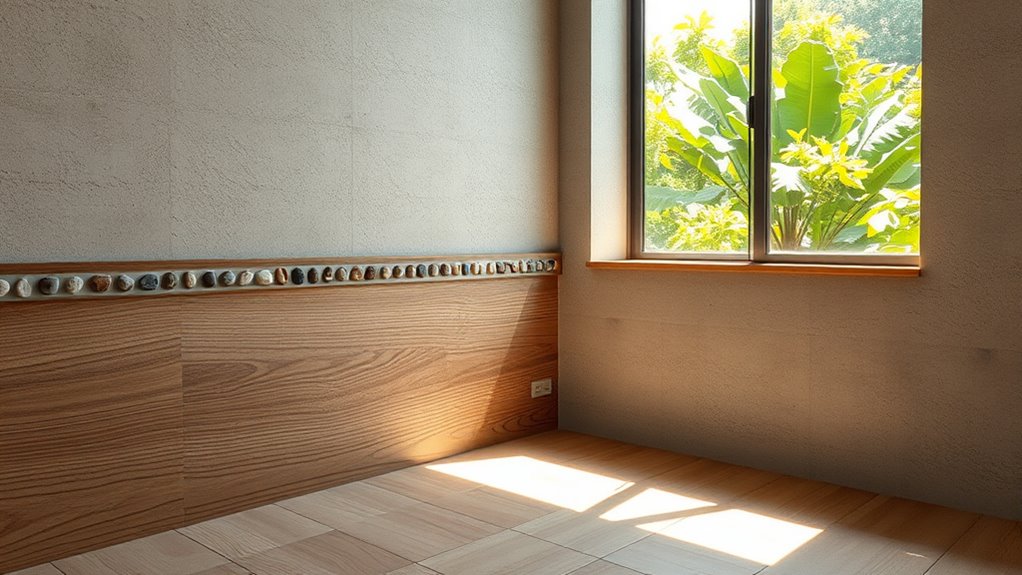
Selecting interior finishes with environmental impact and sustainability in mind can substantially reduce your home’s carbon footprint. Opt for materials that are renewable, locally sourced, or have low embodied energy, like natural stone or recycled content products. Avoid finishes with harmful chemicals or volatile organic compounds (VOCs), which can pollute indoor air and harm your health. Consider eco-friendly alternatives such as clay plasters or bamboo, which grow quickly and replenish easily. Choose finishes that are durable and long-lasting to minimize waste and replacement needs over time. Additionally, look for certifications like LEED or GreenGuard, which indicate environmentally responsible manufacturing. Implementing best application methods ensures optimal performance and longevity of eco-friendly finishes. Making thoughtful choices now helps protect the environment, conserves resources, and creates a healthier living space for you and your family.
Long-term Performance and Repairs
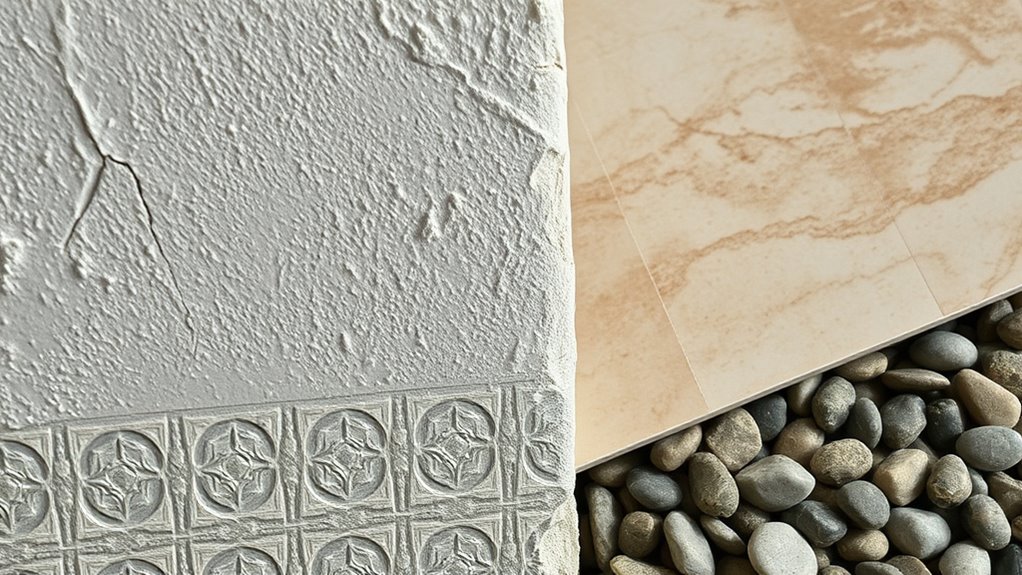
When choosing interior finishes, you should consider how they hold up over time, including their durability and resistance to wear. Think about how easy it will be to maintain or repair them if needed, as well as how long they’re likely to last. Making smart choices now can save you time and money on repairs in the future. Additionally, selecting finishes that incorporate aesthetic wall organization solutions can enhance both functionality and visual appeal in your space.
Durability and Wear Resistance
Because durability and wear resistance are essential for long-term performance, it’s important to contemplate how different finishes handle daily use and potential damage. Tile surfaces are highly resistant to scratches, moisture, and stains, making them ideal for high-traffic areas. Pebble finishes offer resilience but can sometimes trap dirt and require regular cleaning. Plaster, while versatile, may chip or crack over time if not properly maintained. Factors like the material’s hardness, porosity, and finish influence how well it withstands wear.
- Tile resists scratches, stains, and moisture
- Pebble surfaces are durable but need cleaning
- Plaster can crack or chip with impact
- Sealants can enhance wear resistance
- Proper installation extends longevity
Maintenance and Repair Ease
Maintenance and repair ease considerably impact the long-term performance of interior finishes, as some materials are simpler to keep in good condition and fix when issues arise. Tile surfaces are durable and resistant to stains, making them relatively easy to clean and repair with simple replacements if cracked or damaged. Pebble finishes can be more challenging; their uneven surface traps dirt and can be harder to patch seamlessly. Plaster, while aesthetically appealing, may crack over time and require skilled repairs to restore its smooth appearance. Generally, tiles offer the easiest maintenance, with quick fixes available for damage. Pebble and plaster finishes require more effort, often involving professional repairs and careful cleaning to maintain their look and integrity over time. Additionally, choosing tuning options that enhance your vehicle’s performance can reduce the likelihood of mechanical issues that might require interior repairs due to vibrations or other stresses.
Longevity of Material Choices
Choosing durable interior finishes means considering how well they hold up over time and how easily they can be repaired. Tile, pebble, and plaster each have different long-term performances. Tile is highly durable, resisting moisture and stains, making repairs straightforward if a section cracks. Pebble finishes may need periodic sealing to prevent damage, but minor chips are repairable. Plaster can last decades if properly maintained, though cracks might develop and require patching. Consider the material’s resistance to wear, moisture, and temperature fluctuations. Easy repairs extend the lifespan of your finish, saving you money and effort. Ultimately, your choice depends on your willingness to maintain and repair, as well as the environment where the finish is installed.
Frequently Asked Questions
Which Finish Is Best for High-Moisture Areas Like Bathrooms?
For high-moisture areas like bathrooms, tile is your best choice. It’s durable, water-resistant, and easy to clean, making it ideal for wet environments. You should consider glazed ceramic or porcelain tiles because they prevent water penetration and resist mold. Avoid plaster or pebble finishes in these spaces, as they’re more prone to water damage and harder to maintain over time. Tile keeps your bathroom looking great and functioning properly.
How Do Tile, Pebble, and Plaster Compare in Thermal Insulation?
Thinking of thermal insulation? Like a cozy blanket, tile generally provides solid insulation, keeping heat in. Pebble finishes offer moderate insulation with a textured feel, while plaster is less effective but still adds some warmth. If insulation’s your priority, tile is your best bet, especially in colder climates. Pebble offers a natural aesthetic with decent insulation, and plaster is simple but less insulating—consider your climate and comfort needs.
Are There Hypoallergenic Options Among These Finishes?
Yes, you have hypoallergenic options among these finishes. Tile is naturally resistant to mold, dust, and allergens, making it a great choice if you’re sensitive. Plaster, especially lime or clay varieties, also offers hypoallergenic benefits because it doesn’t trap dust or allergens. Pebble finishes can be hypoallergenic if sealed properly, but they might trap dust in porous areas. Always choose finishes that are non-toxic and easy to clean to reduce allergens effectively.
Can These Finishes Be Applied Over Existing Surfaces?
Applying these finishes is like adding a fresh coat of paint to an old canvas—you can often do it over existing surfaces. You might need to prep the area by cleaning, repairing, or sanding to guarantee good adhesion. For tile or plaster, you may need a primer. Always check the specific product instructions and consider consulting a professional to ensure a smooth, long-lasting finish.
What Are the Typical Lifespan Differences Among the Finishes?
You can expect tile to last 20-50 years with proper maintenance, making it the most durable option. Pebble finishes often last around 10-20 years, depending on exposure and care, while plaster typically endures 10-30 years but may require more frequent repairs over time. Your choice depends on how much longevity you want and how well you maintain the surface. Proper upkeep can extend the lifespan of all finishes.
Conclusion
Choosing between tile, pebble, or plaster is like selecting the perfect brushstroke for your home’s canvas. Each option paints a different story—durability, style, and sustainability woven into every layer. Think of your space as a garden; your choice shapes its character and resilience. Trust your instincts, and let your vision guide you. With the right finish, your home becomes a timeless masterpiece, inviting comfort and beauty to dance under your fingertips.

